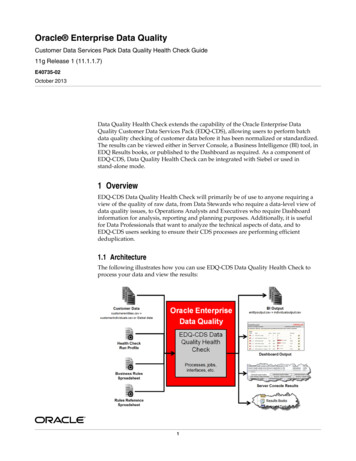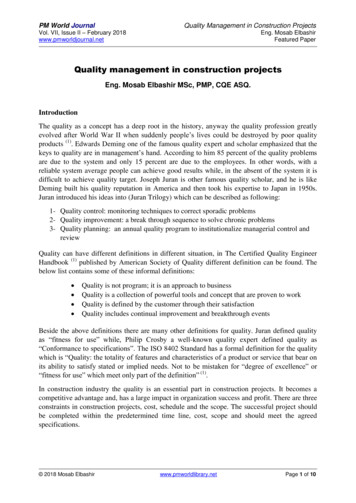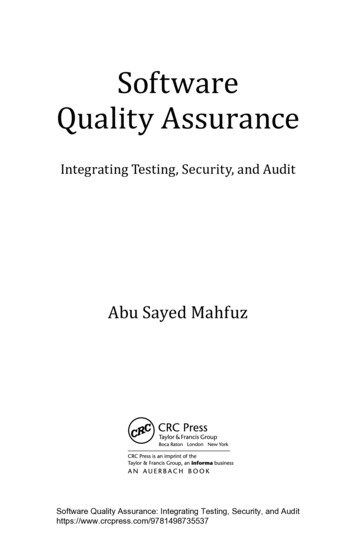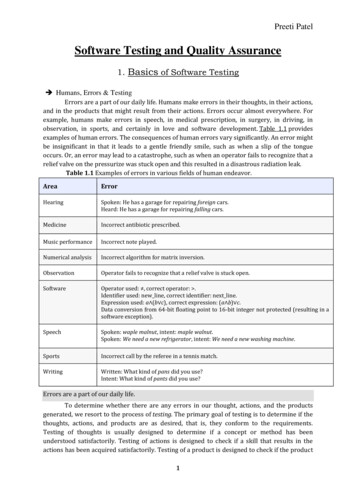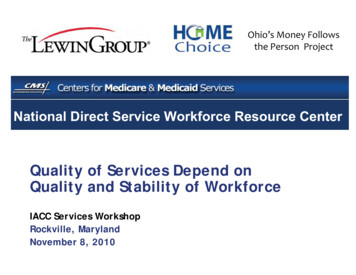
Transcription
Ohio’s Money Followsthe Person ProjectNational Direct Service Workforce Resource CenterQuality of Services Depend onQuality and Stability of WorkforceIACC Services WorkshopRockville, MarylandNovember 8, 2010
Overview LTSS Workforce Challenges Importance of Training Ohio’s Experience Training Recommendations: Reward HCBS programs with quality training programs Take cross-population, cross-program, holistic approach in all trainingeffortsStrengthen partnerships between DHHS and Dept. of Labor/ WorkforceInfrastructurewww.lewin.com1
CMS DSW Resource Centerwww.dswresourcecenter.orgOur mission is to support efforts to improverecruitment and retention of direct service workerswho help people with disabilities and older adults tolive independently and with dignity. Raising Awareness Disseminating Best Practices Building Consensus and Promoting Partnership Providing Technical Assistancewww.lewin.com2
Blurring Lines of Long Term Services andSupports WorkforceDirect Support ProfessionalsInformal Support Providers Agency-based Providers Family Individual Providers Friends NeighborsPaid Support Providers Transition coordinators Support brokers Options counselors Peer supportswww.lewin.com3
The LTSS Workforce Crisis Increasing demand for LTSS, especially in home andcommunity-based settings Supply of workers not growing fast enough to keep up withdemand Low wages, few benefits Persistently high turnover and low retention Lack of training opportunities, training standards Workforce development initiatives tend to focus on oneprogram or one populationwww.lewin.com4
Why is LTSS Training Important? Improves competence Increases confidence Increases jobHigher QualityServicessatisfaction Improves retentionLower Cost Reduces turnoverwww.lewin.com5
LTSS Training Challenges Federal training requirements for CNAs and Medicare HomeHealth Aids only State training requirements vary tremendously Typically different across programs and populations Typically minimal in HCBS programs Requirements rarely include competencies related to independentliving, behavioral support, social integration Hard for states to fund training programs Hard for employers and workers to pay for training Hard to engage national workforce training infrastructure - WIBswww.lewin.com6
DOL Registered Apprenticeship LTSS Direct Service: Direct Support Professional (New!), Home HealthAid, Health Support Specialist, Certified Nursing Assistant Provides a training curriculum and career path Includes experiential learning on the job, related classroom instruction,and peer mentoring Apprentices that complete the program are eligible for incrementalwage increases that align with their enhanced job proficiencySeptember 2010: DOL Announced New Apprenticeship for DirectSupport Professionals Based on NADSP n 2010 31 NADSP ANCOR.pdfwww.lewin.com7
Ohio’s Money Follows the Person (MFP)Demonstration ProjectHelping Ohioans Move, Expanding ChoiceIACC Services Workshop Rockville,MarylandNovember 8, 2010Erika Robbins, MFP Project Director
History Ohio Health Care Workforce Advisory Council, 2004 Jobs Cabinet Healthcare Workforce ShortageCommittee, 2006 Unified Long-Term Care System Report, 2008 Ohio Dept of DD Futures Report, 2008 Ohio board of Regents Strategic Plan for HigherEducation, 2008 Ohio Dept. of Mental Health Strategic Plan Ohio Dept. of Alcohol of Drug Addiction Strategic PlanUpdate*****Money Follows the Person Demonstration GrantGoal9
Ohio’s Current SystemCurrent State Each sector has its ownfunding, policy, service andadvocacy systemsEmployers, occupationaltitles and trainingrequirements vary bothwithin and across sectorsRSCDDHealthODJ F S OHPAgingMentalHealth &ODADAS10
Ohio’s Current SystemHealth CareNursingPersonalCare AidesDirectSupportProfessionalsStateTestedNurse AidesHomeHealth AidesIndependentProviders“One-Way Street” connected to the only statewide certificated sector Home and community based workers “startfrom scratch” if they want the STNA credentialto work in a nursing home STNA training does not include “home and 11
Health and Human Service Lattice Expanding and increasingflexibility in the workforceHealthServicesHumanServices Connecting all directservice workers to careerpathway opportunitiesSTNA – DSP – HHA – PCA – IPUnified Workforce12
Unified Direct Service Workforce:Identifying the “Core” Core Competencies- requiredwithout regard to setting orsectorRSCDD Provides a unifying threadthrough system silos Differences are acknowledgedthrough FSMentalHealth &Alc./Drug13
MFP Sub-Grant withThe Ohio State University Executed in November 2010 Multi-Phase Project Intersects with the recently awarded HealthCare Workforce Planning Grant– Will assess Ohio’s current health workforce includingactivities such as gathering and analyzing data,examining current resources, policies and practices, andidentifying ways to remove barriers at state and locallevels.– Expected to result in 10 to 25% increase in primary careworkforce over a 10-year period.14
MFP Sub-Grant PhasesPhase 1: Develop a University Consortium ofExperts in labor market, workforce, secondary careertechnical education, long term services and supports,social work, special education, health administration,public health, mental health, nursing, gerontology,developmental disabilities. First meeting of theconsortium is 11/10/10.Phase 2a:Conduct research projects (e.g. astatewide and regional description of the size, diversity,and geographic variation of the workforce, interrelationships and impact of pay benefits and trainingquality link to self15
MFP Sub-Grant PhasesPhase 3: Develop a modular content (includes pilots ofcontent across sectors)– 2011/2012.Phase 4: Develop a modular assessment system (includespilots of assessment system across sectors)– 2011/2012.Phase 5: Develop a delivery system for assessment –2013/2014.Phase 6: Develop articulation and transfer agreements formodules with the Ohio Board of Regents and developrequirements for testing centers and proctors – 2013/2014.16
MFP Sub-Grant PhasesPhase 7: Make modular assessments available statewide andconnect to a web-based “front door” workforce center –2015 .Phase 8: Modify Medicaid provider requirements to reflectmodular assessment. Validate potential for employers toqualify as apprenticeships by default.Phase 9: Implement a competency based Medicaidreimbursement structure based on % staff at variouscompetency levels and “pass through” portion of rate toemployees of agencies.17
What Can DHHS Do to Improve the LTSSWorkforce?1.2.Reward HCBS Programs with Quality Training Programs Develop better mechanisms to pay for training through Medicaid program Offer financial incentives (e.g. higher Federal match, higher reimbursement rates) tostates and employers that provide competency-based trainingStrengthen partnerships between DHHS and Dept. of Labor/ Workforce Infrastructure 3.Opportunities through Registered Apprenticeship Program and High Growth JobsInitiativesTake cross-population, cross-program, holistic approach in all training efforts Only fund workforce or training program or initiative that benefit workers in all publicprograms and all consumer populations. Siloed initiatives do a disservice to workersand people with disabilities.Report: Synthesis of DSW Demographics and wnload file.php?fileId 394www.lewin.com18
Carrie Blakeway, Senior ConsultantThe Lewin Groupcarrie.blakeway@lewin.com703-269-5711Erika Robbins, Ohio MFP Project DirectorOhio Jobs and Family ct Service Workforce Resource Centerinfo@dswresourcecenter.org1-877-822-2647The Lewin Group Health care and human services policy research and consulting www.lewin.com3130 Fairview Park Drive, Suite 800 Falls Church, VA 22042 From North America, call toll free: 1-877-227-5042 inquiry@lewin.comwww.lewin.com19
Erika Robbins, Ohio MFP Project Director . Ohio Jobs and Family Services . erika.robbins@jfs.ohio.gov . 614-752-3738 . Direct Service Workforce Resource Center . info@dswresourcecenter.org 1-877-822-2647 . The Lewin Group Health care and human services policy research and consulting www.lewin.com




